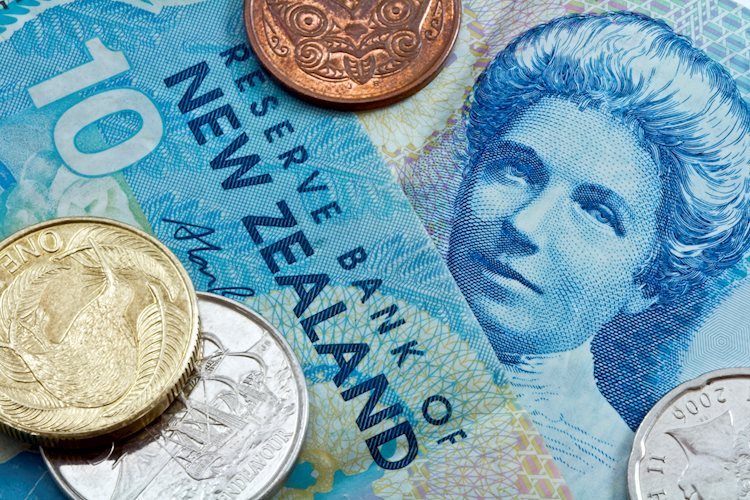- The New Zealand Dollar holds positive ground in Tuesday’s early Asian session.
- Reduced bets for a RBNZ rate cut and signs of stronger demand from China supported the Kiwi.
- Rising Middle East geopolitical risks might limit the pair’s downside.
- The US Producer Price Index (PPI) will be in the spotlight on Tuesday before the RBNZ rate decision.
The New Zealand Dollar (NZD) trades on a stronger note on Tuesday amid the modest decline of the Greenback. The stronger-than-expected New Zealand employment report last week diminished the possibility of the Reserve Bank of New Zealand (RBNZ) rate cut on Wednesday, which continues to support the Kiwi. Additionally, signs that Chinese demand is improving could contribute to the NZD’s upside as China is New Zealand’s largest trading partner.
On the other hand, safe-haven buying amid elevated geopolitical tensions in the Middle East might push the US Dollar (USD) higher. The RBNZ interest rate decision and press conference on Wednesday will be closely watched. The hawkish messages from RBNZ Governor Adrian Orr might lift the NZD against the USD in the near term. Elsewhere, traders will keep an eye on the US economic data, which should shed further light on the Federal Reserve’s (Fed) outlook for rates. The Producer Price Index (PPI), Consumer Price Index (CPI) and Retail Sales will be released on Tuesday, Wednesday and Thursday, respectively.
Daily Digest Market Movers: New Zealand Dollar edges higher, with all eyes on RBNZ Interest Rate Decision
- ING’s FX analysts Francesco Pesole and Chris Turner noted, “We narrowly favor a hold in August but see a greater chance that the RBNZ will cut 50 bps in October after the Fed has moved first. Ultimately, with over 90 bps of easing priced in by year-end, the difference between a hawkish cut and a dovish hold may not be huge: we still think easing bets can be trimmed by year-end.”
- 12 of 21 economists surveyed by Bloomberg expect the RBNZ to leave its OCR unchanged at 5.5% on Wednesday.
- Over half of the NZIER Shadow Board expects a 25 bps reduction in the OCR is required due to the persistent weakening of the New Zealand economy. The other members suggested that the New Zealand central bank should keep the OCR at 5.50%.
- The US Producer Price Index (PPI) is expected to drop to 0.1% MoM in July from 0.2% in June.
- Traders have priced in a nearly 47.5% chance that the Fed will cut the rate by 50 basis points (bps) in the September meeting, down from 52.5% last Friday, according to the CME FedWatch Tool.
Technical Analysis: New Zealand Dollar’s bearish trend prevails
The New Zealand Dollar trades stronger on the day. The bearish outlook of the NZD/USD pair remains intact on the daily chart as the pair holds below the key 100-day Exponential Moving Average (EMA). Nonetheless, if the price decisively crosses above the key EMA, it would resume the uptrend. Meanwhile, the 14-day Relative Strength Index (RSI) is slightly above the 50 midline, indicating a potential shift towards more bullish sentiment in the short term.
A bullish turn could expose NZD/USD to the 100-period EMA near 0.6050. Any follow-through buying above this level will see a rally to 0.6082, the upper boundary of the Bollinger Band. Further north, the next upside target emerges at 0.6134, a high of July 8.
On the flip side, a low of August 6 at 0.5912 acts as an initial support level for the pair. Extended losses below this level could pave the way to 0.5856, a low of July 29 and the lower limit of the Bollinger Band.
RBNZ FAQs
The Reserve Bank of New Zealand (RBNZ) is the country’s central bank. Its economic objectives are achieving and maintaining price stability – achieved when inflation, measured by the Consumer Price Index (CPI), falls within the band of between 1% and 3% – and supporting maximum sustainable employment.
The Reserve Bank of New Zealand’s (RBNZ) Monetary Policy Committee (MPC) decides the appropriate level of the Official Cash Rate (OCR) according to its objectives. When inflation is above target, the bank will attempt to tame it by raising its key OCR, making it more expensive for households and businesses to borrow money and thus cooling the economy. Higher interest rates are generally positive for the New Zealand Dollar (NZD) as they lead to higher yields, making the country a more attractive place for investors. On the contrary, lower interest rates tend to weaken NZD.
Employment is important for the Reserve Bank of New Zealand (RBNZ) because a tight labor market can fuel inflation. The RBNZ’s goal of “maximum sustainable employment” is defined as the highest use of labor resources that can be sustained over time without creating an acceleration in inflation. “When employment is at its maximum sustainable level, there will be low and stable inflation. However, if employment is above the maximum sustainable level for too long, it will eventually cause prices to rise more and more quickly, requiring the MPC to raise interest rates to keep inflation under control,” the bank says.
In extreme situations, the Reserve Bank of New Zealand (RBNZ) can enact a monetary policy tool called Quantitative Easing. QE is the process by which the RBNZ prints local currency and uses it to buy assets – usually government or corporate bonds – from banks and other financial institutions with the aim to increase the domestic money supply and spur economic activity. QE usually results in a weaker New Zealand Dollar (NZD). QE is a last resort when simply lowering interest rates is unlikely to achieve the objectives of the central bank. The RBNZ used it during the Covid-19 pandemic.













